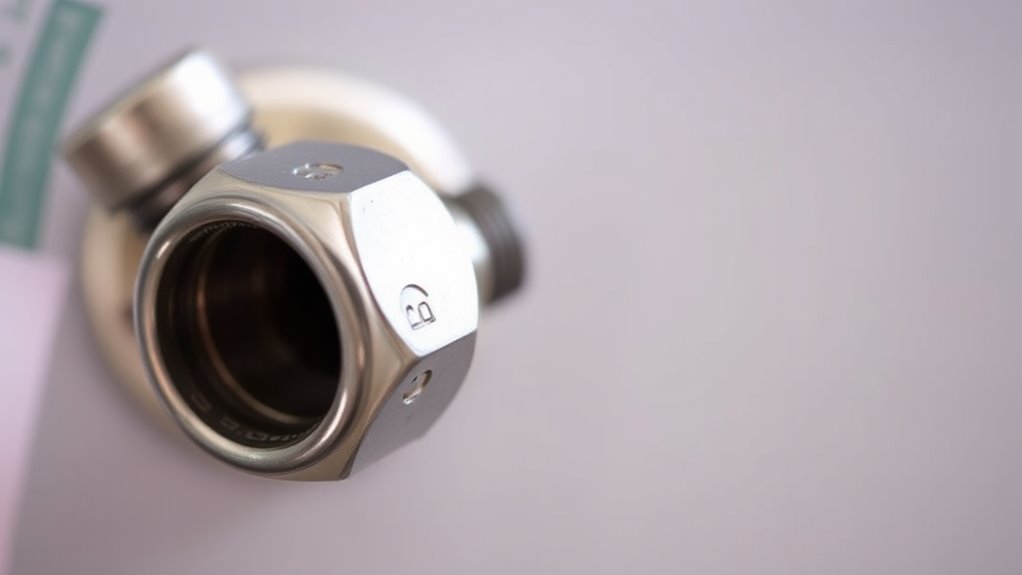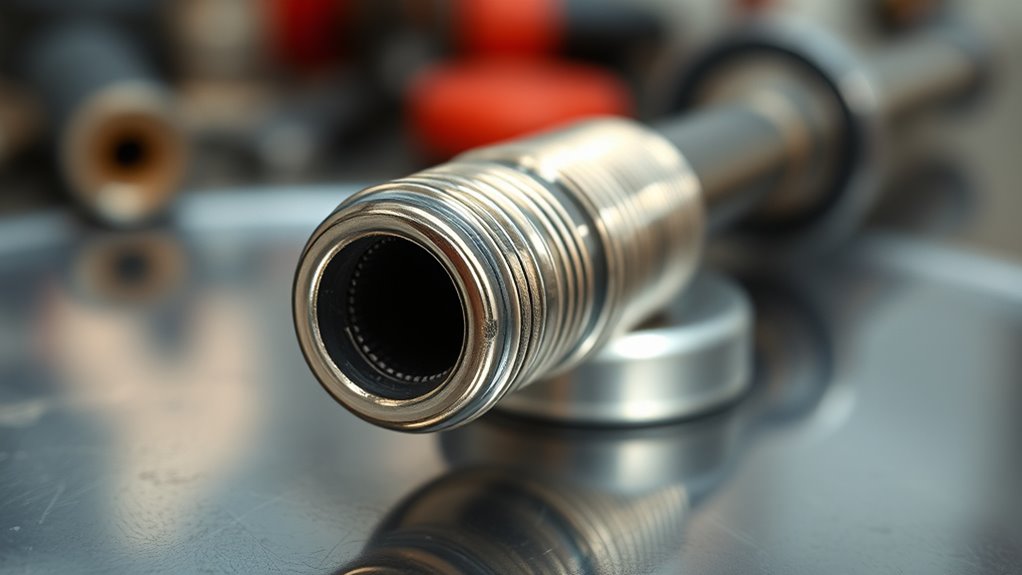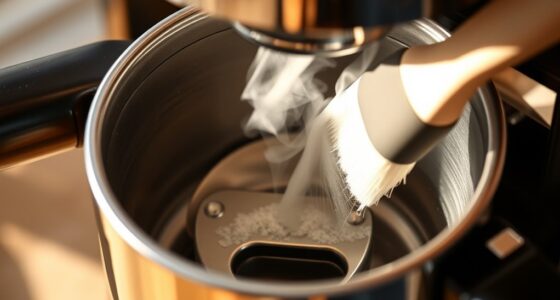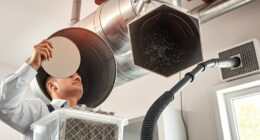Your water heater’s anode rod is a small but vital part that costs around $20 and prevents rust from damaging the tank. It works by sacrificing itself to corroding first, protecting the metal interior. Over time, it wears out and needs replacement—usually every 2-3 years—to keep your water heater running smoothly. If you’d like to learn how to inspect or replace it and extend your heater’s lifespan, there’s more to uncover.
Key Takeaways
- Anode rods are affordable, essential components (~$20) that protect water heaters from rust and corrosion.
- They work by sacrificing themselves to prevent tank walls from rusting, extending the heater’s lifespan.
- Regular inspection and replacement every 2-3 years ensure continued rust prevention.
- Proper installation and maintenance optimize the anode rod’s effectiveness in preventing corrosion.
- Replacing a worn anode rod is a simple, cost-effective way to avoid costly water heater repairs.

A water heater anode rod plays a essential role in protecting your tank from corrosion, which can considerably extend its lifespan. This small but necessary part attracts corrosive elements in the water, sacrificing itself to prevent rust from forming on the tank’s interior. Without it, your water heater is vulnerable to deterioration, leading to leaks, reduced efficiency, and costly repairs. By understanding how an anode rod works and performing regular maintenance, you can keep your water heater functioning smoothly for years to come.
Corrosion prevention is the primary purpose of the anode rod. Made from materials like magnesium, aluminum, or zinc, the rod is installed inside the tank and acts as a sacrificial anode. When minerals and water interact with the metal tank, the anode corroded first, protecting the tank’s metal lining from rust. Over time, the anode deteriorates, sacrificing itself to safeguard the tank. That’s why routine inspection and timely replacement are essential. If the anode becomes fully corroded, the tank becomes exposed to corrosion, leading to leaks and tank failure.
The anode rod protects your water heater by sacrificing itself to prevent tank corrosion.
Maintaining your water heater’s anode rod is straightforward and can save you significant money. First, turn off the power supply—gas or electric—before inspecting the rod. Drain a few gallons of water to access the anode, which is usually located on top of the tank. Unscrew the anode rod using a socket wrench, and check its condition. If it’s heavily corroded, covered in calcium buildup, or less than half an inch thick, it’s time for a replacement. Regular inspections—every 2-3 years—can catch issues early and prevent costly damage.
When replacing the anode rod, select a compatible type and size for your water heater. Installing a new anode is simple: screw it in securely, ensuring a tight fit to prevent leaks. Refill the tank, restore power, and you’re all set. Remember, maintenance tips like flushing sediment buildup periodically can also prolong the life of your water heater and its anode. Sediment can accelerate corrosion, so draining the tank annually helps remove mineral deposits that might otherwise hinder the anode’s effectiveness.
In essence, paying attention to your anode rod isn’t just about saving a few dollars; it’s about protecting a critical appliance that supplies your home with hot water. Regular inspections and replacements are minor tasks that yield major benefits—preventing rust, extending your water heater’s life, and saving you from unexpected breakdowns. With a little proactive maintenance, you keep your water heater running efficiently, and you avoid the costly consequences of neglected corrosion. Additionally, understanding the key components of sound design can help you troubleshoot and improve your maintenance routines effectively.
Frequently Asked Questions
How Often Should I Replace My Water Heater Anode Rod?
You should replace your water heater anode rod every 3 to 5 years, depending on water quality. Regular anode rod inspection during water heater maintenance helps determine if it’s corroded or depleted. By doing this, you prevent rust and extend your heater’s lifespan. Keep an eye on signs like increased sediment or rust-colored water, and replace the anode rod promptly to maintain superior performance and protect your investment.
Can I Install an Anode Rod Myself or Need a Professional?
Ever wondered if you can tackle that water heater anode rod replacement yourself? It’s doable with some DIY installation skills, but beware—mistakes could cause leaks or damage. If you’re unsure or uncomfortable, seeking professional help guarantees the job gets done right. Consider your tools and experience; if you’re confident, go ahead. Otherwise, trusting a pro might be the smarter choice, saving time and avoiding costly errors.
What Are the Signs Indicating My Anode Rod Needs Replacement?
You should inspect your anode rod regularly to catch signs it needs replacing. Look for rust formation around the rod or inside the tank during an anode rod inspection. If you notice the rod is heavily corroded or the tank shows signs of rust, it’s time to replace it. Doing this helps prevent further corrosion, extending your water heater’s lifespan and maintaining efficient operation.
Are There Different Types of Anode Rods for Various Water Conditions?
You should know that different anode rods suit various water conditions for ideal corrosion resistance and material compatibility. Magnesium rods work best in soft, municipal water, offering strong protection but corrode faster. Aluminum or zinc rods suit hard water, providing longer-lasting corrosion resistance. Choosing the right type depends on your water’s mineral content, ensuring your tank stays protected without unnecessary corrosion or damage.
How Does Water Quality Affect Anode Rod Lifespan?
Water quality considerably impacts your anode rod’s lifespan. High water mineral content, like calcium and magnesium, accelerates corrosion, reducing the rod’s effectiveness sooner. Likewise, a low pH level makes water more acidic, which speeds up anode deterioration. To extend your rod’s life, monitor your water’s mineral content and pH level regularly. Using water softeners or conditioners can also help protect the anode, ensuring your water heater stays rust-free longer.
Conclusion
Think of the anode rod as a brave knight guarding your water heater’s heart, sacrificing itself to keep rust at bay. For just $20, you’re investing in a tiny hero that shields your hot water supply from corrosion’s relentless attack. With this small but mighty part standing guard, your water heater can keep flowing smoothly like a well-oiled machine. Embrace the power of the anode rod, and let it be the silent protector of your daily comfort.









